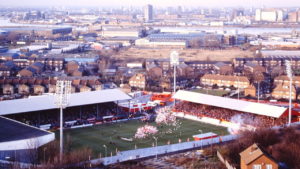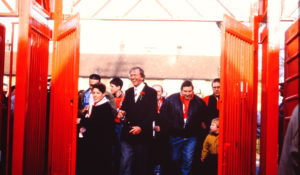One of the defining images in Charlton FC’s history is the bonfire in the middle of The Valley in 1989. It was four years after Charlton fans were banished from their sanctuary, and Charlton had just publicly announced its support for the re-opening of the famous London landmark and work would be underway imminently to prepare the stadium to a suitable standard.
“We were away at Highbury and I just remember the buzz that news had broken the directors said ‘we’re going back to The Valley’,” Chair of the Charlton Athletic Supporters’ Trust, Heather McKinlay recollects. “It was one of those moments you remember.
“That evening, Charlton fans sang ‘Valley Floyd Road’ for the first time, which has now pretty much become our anthem.”

Like a kid participating in the ‘Marshmallow Experiment’, Charlton fans couldn’t contain themselves, and thus proceeded to make the lives of the construction workers easier by breaking into the desolate Valley to stage a mass clear up and set fire to their troubled recent past. According to McKinlay, the famous image of the bonfire represents “the fans claiming the ground back.”
McKinlay suggests it was the then-chairman Roger Alwen’s wife, Heather Alwen’s, idea for the fans to “reclaim the ground,” saying: “It was really a PR stunt. The work that was being done to de-weed the terrace, and gather up the rubbish, and have the bonfire on the pitch… JCB’s were coming in the next day, so it was more symbolic really.”
Into The Wilderness
The ‘wilderness’ years of the 1980s was a slow build-up. Decades of league fluctuation, ownership aggravation, and stadium disrepair resulted in Charlton going into administration.
What followed was many fans’ worst nightmare: exile from their stadium – a stadium that at one point proudly boasted the highest capacity capability in English football. So, the Charlton fans travelled south to Selhurst Park where they would be forced to watch their team for six years.
Rather surprisingly considering the turmoil off the pitch, Charlton began to make progress on it, with a surprise promotion to the old First Division in their first year at Selhurst Park. However, you would be mistaken if you thought for Charlton fans this disguised the pain of being away from home.
“Squatters”
“I remember vividly queuing up to go to Selhurst in the First Division and I remember having the conversation with my dad, saying ‘we’d rather be in the Second Division at The Valley, than in the First Division at Selhurst’,” McKinlay said. “A lot of people didn’t go to Selhurst [despite being promoted], a lot of people did boycott.
“We never felt at home at Selhurst Park. Every game was an away game, effectively,” she added. “It was not our ground; we were just squatting. While I can vividly remember games before we left The Valley, I don’t remember many games at Selhurst.”
‘The Valley Party’
Despite a group of supporters purchasing the club in 1984, The Valley remained under the ownership of the previous owner, and after years of disrepair, financial struggles, and no legal right to the stadium, the club was forced to leave.
Having witnessed Greenwich Council vote against the planning permission for the renovation of The Valley, despite Charlton’s owner publicly announcing their intention to return, the primarily working-class fans of Charlton started a practical resistance: ‘The Valley Party’ – a legitimate opposition to the Political Elite with the renovation of The Valley the sole policy in the manifesto.
While The Valley Party won zero seats in the Greenwich Council Elections, they did win almost 15,000 votes which represented 11% of the voter share, and this was enough to scare the mainstream political parties into granting planning permission.
“A Football Club Belongs To The Fans”
“Ultimately, regardless of what documentation might say, a football club belongs to the fans,” McKinlay said. “We were saying ‘it’s our club’.
“Nowadays, you have multi-millionaires and benefactors putting the money into the clubs, and unfortunately, it’s very difficult for fans to have proper ownership. For a lot of clubs, it is bound by the place, and The Valley for me is Charlton, and Charlton is The Valley.
“It’s where all your memories are. It’s part of you, and your football club is that immeasurable. The whole period shows the length people will go to, to protect their club.”

The day was December 5th 1992, and after eight years away, Charlton fans returned home. The tarmac and paint were not yet dry, and temporary stands were in place of the famous East Terrace, but they didn’t care.
“When we finally did get back, that day was just incredible,” McKinlay said. “It immediately sold out.
“It wasn’t The Valley as we knew it before, but it was still very much The Valley. It looked very different to when I was going in the 1970s and 80s, but it was still very much The Valley: it’s in a dip, it’s among Victorian suburban streets – it’s was the same even though it looked very different.”
Featured image: © Charlton Athletic FC



